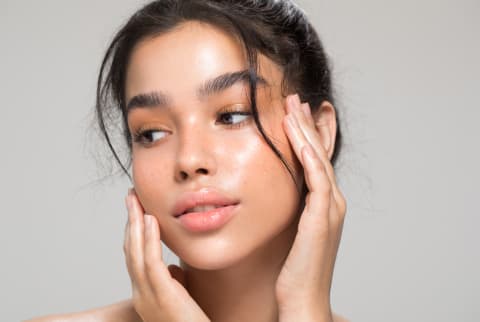Advertisement
What Is Skin Flooding? We Explain The Common Skin Care Tip


Another day, another TikTok hack posing as a brand-new trick. These "trends" aren't exactly groundbreaking (many even make beauty experts roll their eyes), but to be honest, I can't get enough of these clever tricks. If a quippy name is what it takes for people to adopt healthy skin habits, I'm totally game!
Consider skin cycling, for example: Folding in necessary breaks from heavy-duty actives to focus on repair is a very solid habit (and one that derms, including board-certified dermatologist Whitney Bowe, M.D., have been championing for ages). But it wasn't until Bowe deemed the practice "skin cycling" that it completely took off and transformed into the beloved beauty practice it is today. Now, tons of folks are finally setting aside their potent retinols and exfoliators and prioritizing barrier-strengthening ingredients—and their glowing complexions thank them for it.
Well, another age-old trick has captured the masses and rebranded into something buzzy. Allow me to (re)introduce you to skin flooding.
What is skin flooding?
You may be doing it already without even knowing it: All "skin flooding" means is applying your hydrating formulas onto damp skin. That way, the humectants in those products (hyaluronic acid, glycerin, etc.) can pull that water into the surface layers of your skin, making you appear plump and full of moisture.
It's an especially helpful tip during the drier winter months (ahem, right about now). See, when humidity is high, humectants have an easier time pulling in water from the outside air; but when that humidity dips, you'll want to make sure those ingredients have enough water to use.
How it works.
Humectants are water-loving, so you actually want to give them the water they need to do their job properly. As board-certified dermatologist Angelo Landriscina, M.D., once said, "The humectants in your products, like hyaluronic acid and glycerin, will have an easier time holding on to moisture if you're providing it." Otherwise, they can actually pull moisture from the deeper layers of the dermis, which can leave your skin even drier than before.
While the term "skin flooding" may make you think of a sopping wet face, you don't actually need that much water to do the job. Simply leaving your face slightly damp post-cleanse will do the trick, or you can always re-moisten your skin with a hydrating toner or essence.
How to do it correctly.
First and foremost: Wash your face. A good skin routine always starts with a clean canvas. After cleansing, simply blot your face with a towel until it's damp before applying your humectant product. Here's a list of our favorite hyaluronic acid serums, for those in the market.
If you want to infuse your skin with extra hydration, apply a hydrating toner or essence to your skin pre-serum. (My personal favorite is Renée Rouleau's Moisture Infusion Toner.) You can even press the essence into your skin in thin, multiple layers—this is called the K-beauty 7-skin method—until you feel your skin is satisfyingly plump and hydrated.
Layer on your hydrating serum, then lock in that moisture with an occlusive layer, like a cream or oil. All that water on the top layer of your skin can easily evaporate, so you need to slick on an occlusive as the last step of your skin care routine. Feel free to follow up with a barrier cream, if your skin feels especially thirsty.
Finally, if you really want to amp up the hydration, you can opt for an inside-out approach à la hyaluronic acid supplements. Many beauty experts swear by these skin-enhancing ingestibles to "flood" your skin from the inside out; see here for our favorite formulas for hydrated, bouncy Jello skin.
The takeaway.
Skin flooding is by no means a brand-new practice, but it is a quick, helpful phrase to teach folks how to actually hydrate their skin. If you've been swearing by this "hack" for ages, please, carry on! But for those who are struggling with parched skin this winter, maybe all you need is to provide your products with a little more dew.
